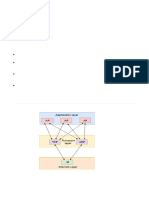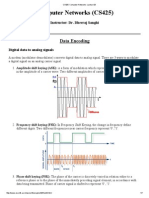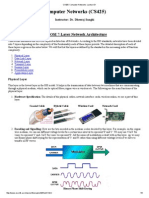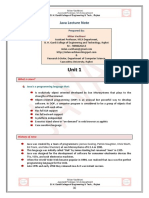Computer Networks (CS425) : Transport Layer Protocol (Continued)
Uploaded by
Anish VeettiyankalComputer Networks (CS425) : Transport Layer Protocol (Continued)
Uploaded by
Anish Veettiyankal11/8/2014
CS425: Computer Networks: Lecture 15
Computer Networks (CS425)
Instructor: Dr. Dheeraj Sanghi
Prev| Next| Index
Transport Layer Protocol (continued)
TCP connection is a duplex connection. That means there is no difference between two sides once the
connection is established.
Salient Features of TCP
Piggybacking of acknowledments:The ACK for the last received packet need not be sent as a
new packet, but gets a free ride on the next outgoing data frame(using the ACK field in the frame
header). The technique is temporarily delaying outgoing ACKs so that they can be hooked on the
next outgoing data frame is known as piggybacking. But ACK can't be delayed for a long time if
receiver(of the packet to be acknowledged) does not have any data to send.
Flow and congestion control:TCP takes care of flow control by ensuring that both ends have
enough resources and both can handle the speed of data transfer of each other so that none of them
gets overloaded with data. The term congestion control is used in almost the same context except
that resources and speed of each router is also taken care of. The main concern is network
resources in the latter case.
Multiplexing / Demultiplexing: Many application can be sending/receiving data at the same time.
Data from all of them has to be multiplexed together. On receiving some data from lower layer,
TCP has to decide which application is the recipient. This is called demultiplexing. TCP uses the
concept of port number to do this.
TCP segment header:
Explanation of header fields:
Source and destination port :These fields identify the local endpoint of the connection. Each host
may decide for itself how to allocate its own ports starting at 1024. The source and destination
http://www.cse.iitk.ac.in/users/dheeraj/cs425/lec15.html
1/4
11/8/2014
CS425: Computer Networks: Lecture 15
socket numbers together identify the connection.
Sequence and ACK number : This field is used to give a sequence number to each and every
byte transferred. This has an advantage over giving the sequence numbers to every packet because
data of many small packets can be combined into one at the time of retransmission, if needed. The
ACK signifies the next byte expected from the source and not the last byte received. The ACKs are
cumulative instead of selective.Sequence number space is as large as 32-bit although 17 bits would
have been enough if the packets were delivered in order. If packets reach in order, then according
to the following formula:
(sender's window size) + (receiver's window size) < (sequence number space)
the sequence number space should be 17-bits. But packets may take different routes and reach out
of order. So, we need a larger sequence number space. And for optimisation, this is 32-bits.
Header length :This field tells how many 32-bit words are contained in the TCP header. This is
needed because the options field is of variable length.
Flags : There are six one-bit flags.
1. URG : This bit indicates whether the urgent pointer field in this packet is being used.
2. ACK :This bit is set to indicate the ACK number field in this packet is valid.
3. PSH : This bit indicates PUSHed data. The receiver is requested to deliver the data to the
application upon arrival and not buffer it until a full buffer has been received.
4. RST : This flag is used to reset a connection that has become confused due to a host crash or
some other reason.It is also used to reject an invalid segment or refuse an attempt to open a
connection. This causes an abrupt end to the connection, if it existed.
5. SYN : This bit is used to establish connections. The connection request(1st packet in 3-way
handshake) has SYN=1 and ACK=0. The connection reply (2nd packet in 3-way handshake)
has SYN=1 and ACK=1.
6. FIN : This bit is used to release a connection. It specifies that the sender has no more fresh
data to transmit. However, it will retransmit any lost or delayed packet. Also, it will continue
to receive data from other side. Since SYN and FIN packets have to be acknowledged, they
must have a sequence number even if they do not contain any data.
Window Size : Flow control in TCP is handled using a variable-size sliding window. The Window
Size field tells how many bytes may be sent starting at the byte acknowledged. Sender can send the
bytes with sequence number between (ACK#) to (ACK# + window size - 1) A window size of zero
is legal and says that the bytes up to and including ACK# -1 have been received, but the receiver
would like no more data for the moment. Permission to send can be granted later by sending a
segment with the same ACK number and a nonzero Window Size field.
Checksum : This is provided for extreme reliability. It checksums the header, the data, and the
conceptual pseudoheader. The pseudoheader contains the 32-bit IP address of the source and
destination machines, the protocol number for TCP(6), and the byte count for the TCP segment
(including the header).Including the pseudoheader in TCP checksum computation helps detect
misdelivered packets, but doing so violates the protocol hierarchy since the IP addresses in it
belong to the IP layer, not the TCP layer.
Urgent Pointer : Indicates a byte offset from the current sequence number at which urgent data
are to be found. Urgent data continues till the end of the segment. This is not used in practice. The
same effect can be had by using two TCP connections, one for transferring urgent data.
Options : Provides a way to add extra facilities not covered by the regular header. eg,
Maximum TCP payload that sender is willing to handle. The maximum size of segment is
called MSS (Maximum Segment Size). At the time of handshake, both parties inform each
other about their capacity. Minimum of the two is honoured. This information is sent in the
options of the SYN packets of the three way handshake.
Window scale option can be used to increase the window size. It can be specified by telling
http://www.cse.iitk.ac.in/users/dheeraj/cs425/lec15.html
2/4
11/8/2014
CS425: Computer Networks: Lecture 15
the receiver that the window size should be interpreted by shifting it left by specified number
of bits. This header option allows window size up to 230.
Data : This can be of variable size. TCP knows its size by looking at the IP size header.
Topics to be Discussed relating TCP
1. Maximum Segment Size : It refers to the maximum size of segment ( MSS ) that is acceptable to
both ends of the connection. TCP negotiates for MSS using OPTION field. In Internet environment
MSS is to be selected optimally. An arbitrarily small segment size will result in poor bandwith
utilization since Data to Overhead ratio remains low. On the other hand extremely large segment
size will necessitate large IP Datagrams which require fragmentation. As there are finite chances of
a fragment getting lost, segment size above "fragmentation threshold " decrease the Throughput.
Theoretically an optimum segment size is the size that results in largest IP Datagram, which do not
require fragmentation anywhere enroute from source to destination. However it is very difficult to
find such an optimum segmet size. In system V a simple technique is used to identify MSS. If H1
and H2 are on the same network use MSS=1024. If on different networks then MSS=5000.
2. Flow Control : TCP uses Sliding Window mechanism at octet level. The window size can be
variable over time. This is achieved by utilizing the concept of "Window Advertisement" based on
:
1. Buffer availabilty at the receiver
2. Network conditions ( traffic load etc.)
In the former case receiver varies its window size depending upon the space available in its
buffers. The window is referred as RECEIVE WINDOW (Recv_Win). When receiver buffer begin
to fill it advertises a small Recv_Win so that the sender does'nt send more data than it can accept.
If all buffers are full receiver sends a "Zero" size advertisement. It stops all transmission. When
buffers become available receiver advertises a Non Zero widow to resume retransmission. The
sender also periodically probes the "Zero" window to avoid any deadlock if the Non Zero Window
advertisement from receiver is lost. The Variable size Recv_Win provides efficient end to end flow
control.
The second case arises when some intermediate node ( e.g. a router ) controls the source to reduce
transmission rate. Here another window referred as COGESTION WINDOW (C_Win) is utilized.
Advertisement of C_Win helps to check and avoid congestion.
3. Congestion Control : Congestion is a condition of severe delay caused by an overload of
datagrams at any intermediate node on the Internet. If unchecked it may feed on itself and finally
the node may start dropping arriving datagrams.This can further aggravate congestion in the
network resulting in congestion collapse. TCP uses two techniques to check congestion.
1. Slow Start : At the time of start of a connection no information about network conditios is
available. A Recv_Win size can be agreed upon however C_Win size is not known. Any
arbitrary C_Win size can not be used because it may lead to congestion. TCP acts as if the
window size is equal to the minimum of ( Recv_Win & C_Win). So following algorithm is
used.
1. Recv_Win=X
2. SET C_Win=1
3. for every ACK received C_Win++
2. Multiplicative decrease : This scheme is used when congestion is encountered ( ie. when a
segment is lost ). It works as follows. Reduce the congestion window by half if a segment is
lost and exponentially backoff the timer ( double it ) for the segments within the reduced
window. If the next segment also gets lost continue the above process. For successive losses
this scheme reduces traffic into the connection exponentially thus allowing the intermediate
nodes to clear their queues. Once congestion ends SLOW START is used to scale up the
http://www.cse.iitk.ac.in/users/dheeraj/cs425/lec15.html
3/4
11/8/2014
CS425: Computer Networks: Lecture 15
transmission.
4. Congestion Avoidance : This procedure is used at the onset of congestion to minimize its effect
on the network. When transmission is to be scaled up it should be done in such a way that it does'nt
lead to congestion again. Following algorithm is used .
1. At loss of a segment SET C_Win=1
2. SET SLOW START THRESHOLD (SST) = Send_Win / 2
3. Send segment
4. If ACK Received, C_Win++ till C_Win <= SST
5. else for each ACK C_Win += 1 / C_Win
5. Time out and Retransmission : Following two schemes are used :
1. Fast Retransmit
2. Fast Recovery
When a source sends a segment TCP sets a timer. If this value is set too low it will result in many
unnecessary treransmissions. If set too high it results in wastage of banwidth and hence lower
throughput. In Fast Retransmit scheme the timer value is set fairly higher than the RTT. The sender
can therefore detect segment loss before the timer expires. This scheme presumes that the sender
will get repeated ACK for a lost packet.
6. Round Trip Time (RTT) : In Internet environment the segments may travel across different
intermediate networks and through multiple routers. The networks and routers may have different
delays, which may vary over time. The RTT therefore is also variable. It makes difficult to set
timers. TCP allows varying timers by using an adaptive retransmission algorithm. It works as
follows.
1. Note the time (t1) when a segment is sent and the time (t2) when its ACK is received.
2. Compute RTT(sample) = (t 2 - t 1 )
3. Again Compute RTT(new) for next segment.
4. Compute Average RTT by weighted average of old and new values of RTT
5. RTT(est) = a *RTT(old) + (1-a) * RTT (new) where 0 < a < 1
A high value of 'a' makes the estimated RTT insensitive to changes that last for a short time
and RTT relies on the history of the network. A low value makes it sensitive to current state
of the network. A typical value of 'a' is 0.75
6. Compute Time Out = b * RTT(est) where b> 1
A low value of 'b' will ensure quick detection of a packet loss. Any small delay will however
cause unnecessary retransmission. A typical value of 'b' is kept at .2
Image References
http://plato.acadiau.ca/courses/comp/Eberbach/comp4343/lectures/transport/Com-TCP/f20_6.gif
back to top
Prev| Next | Index
http://www.cse.iitk.ac.in/users/dheeraj/cs425/lec15.html
4/4
You might also like
- The Gilliam Autism Rating Scale GARS - 2 A Pilot S100% (1)The Gilliam Autism Rating Scale GARS - 2 A Pilot S2 pages
- Google Books Partner Program Standard Terms and ConditionsNo ratings yetGoogle Books Partner Program Standard Terms and Conditions13 pages
- NS Simulation Implementing Large Window Over TCP SACKNo ratings yetNS Simulation Implementing Large Window Over TCP SACK5 pages
- Study Material On TCP: TCP (Transmission Control Protocol)No ratings yetStudy Material On TCP: TCP (Transmission Control Protocol)7 pages
- (TCP) Transmission Control Protocol (TCP) - Header, Definition - JavatpointNo ratings yet(TCP) Transmission Control Protocol (TCP) - Header, Definition - Javatpoint7 pages
- Study of TCP Throughput On Network Simulator Opnet++ by Using Different ParametersNo ratings yetStudy of TCP Throughput On Network Simulator Opnet++ by Using Different Parameters6 pages
- Module 5-6: Manages The Rate of Data Transmission Using The Receiver's Window Size (RWND) To AvoidNo ratings yetModule 5-6: Manages The Rate of Data Transmission Using The Receiver's Window Size (RWND) To Avoid16 pages
- Transport Layer: Pawan Kumar Assistantprofessor Gjus&T, HisarNo ratings yetTransport Layer: Pawan Kumar Assistantprofessor Gjus&T, Hisar26 pages
- TCP Congestion Control NewReno, BIC, Hybrid Illinois, ACC Algorithm Simulation and Analysis Using The NS3No ratings yetTCP Congestion Control NewReno, BIC, Hybrid Illinois, ACC Algorithm Simulation and Analysis Using The NS313 pages
- Internet and Internet Protocol Suite: Version 1 ECE, IIT KharagpurNo ratings yetInternet and Internet Protocol Suite: Version 1 ECE, IIT Kharagpur7 pages
- Analysis of TCP Reno With Two Packet Drops Without Maximum Congestion Window in Network On ChipNo ratings yetAnalysis of TCP Reno With Two Packet Drops Without Maximum Congestion Window in Network On Chip5 pages
- Effect of Maximum Congestion of TCP Reno in Decagon NoCNo ratings yetEffect of Maximum Congestion of TCP Reno in Decagon NoC5 pages
- Number So That Jessie Knows Which Application To Give The DataNo ratings yetNumber So That Jessie Knows Which Application To Give The Data4 pages
- TCP and Udp: by Steve Steinke, Network Magazine Feb 5, 2001 (10:03 AM)No ratings yetTCP and Udp: by Steve Steinke, Network Magazine Feb 5, 2001 (10:03 AM)4 pages
- Introduction to Internet & Web Technology: Internet & Web TechnologyFrom EverandIntroduction to Internet & Web Technology: Internet & Web TechnologyNo ratings yet
- Computer Networks (CS425) : Unix Socket Programming (Contd..)No ratings yetComputer Networks (CS425) : Unix Socket Programming (Contd..)6 pages
- Computer Networking Interview Question and Answer PDFNo ratings yetComputer Networking Interview Question and Answer PDF30 pages
- Computer Networks (CS425) : Transport Layer ProtocolNo ratings yetComputer Networks (CS425) : Transport Layer Protocol3 pages
- Jason Dela Cruz Jose": IT Engineer / Systems EngineerNo ratings yetJason Dela Cruz Jose": IT Engineer / Systems Engineer3 pages
- Computer Networks (CS425) : Unix Socket ProgrammingNo ratings yetComputer Networks (CS425) : Unix Socket Programming4 pages
- Computer Networks (CS425) : Transport Layer Protocol-Implementation IssuesNo ratings yetComputer Networks (CS425) : Transport Layer Protocol-Implementation Issues5 pages
- Computer Networks (CS425) : ARP, RARP, ICMP ProtocolsNo ratings yetComputer Networks (CS425) : ARP, RARP, ICMP Protocols7 pages
- Computer Networks (CS425) : Data EncodingNo ratings yetComputer Networks (CS425) : Data Encoding7 pages
- Computer Networks (CS425) : Instructor: Dr. Dheeraj SanghiNo ratings yetComputer Networks (CS425) : Instructor: Dr. Dheeraj Sanghi7 pages
- Computer Networks (CS425) : Instructor: Dr. Dheeraj SanghiNo ratings yetComputer Networks (CS425) : Instructor: Dr. Dheeraj Sanghi6 pages
- Computer Networks (CS425) : ISO-OSI 7-Layer Network ArchitectureNo ratings yetComputer Networks (CS425) : ISO-OSI 7-Layer Network Architecture5 pages
- Computer Networks (CS425) : Routing AlgorithmsNo ratings yetComputer Networks (CS425) : Routing Algorithms5 pages
- Computer Networks (CS425) : IEEE 802.3 and EthernetNo ratings yetComputer Networks (CS425) : IEEE 802.3 and Ethernet3 pages
- 279817393aams_vol_216_april_2022_a25_p3303-3313_kavita_sheoran,_et_al.No ratings yet279817393aams_vol_216_april_2022_a25_p3303-3313_kavita_sheoran,_et_al.11 pages
- Backup, Recovery, and Media Services For Iseries100% (2)Backup, Recovery, and Media Services For Iseries370 pages
- Mt2Dinvmatlab-A Program in Matlab and Fortran For Two-Dimensional Magnetotelluric InversionNo ratings yetMt2Dinvmatlab-A Program in Matlab and Fortran For Two-Dimensional Magnetotelluric Inversion14 pages
- Jurnal Belanja Hedonic Terhadap Minat BeliNo ratings yetJurnal Belanja Hedonic Terhadap Minat Beli9 pages
- 7 - Pile Raft Foundation Analysis With Superstructure and SubstructureNo ratings yet7 - Pile Raft Foundation Analysis With Superstructure and Substructure22 pages
- IRC5-IRB6600 Prod Man 3HAC020938-001 References RevC enNo ratings yetIRC5-IRB6600 Prod Man 3HAC020938-001 References RevC en82 pages
- (PDF Download) Database Design and Implementation 2nd Edition - Fulll Chapter100% (7)(PDF Download) Database Design and Implementation 2nd Edition - Fulll Chapter49 pages
- Https Tgi - Instituteoncloud.com FeeManagement PrintFeeReceiptNo ratings yetHttps Tgi - Instituteoncloud.com FeeManagement PrintFeeReceipt2 pages
- The Gilliam Autism Rating Scale GARS - 2 A Pilot SThe Gilliam Autism Rating Scale GARS - 2 A Pilot S
- Google Books Partner Program Standard Terms and ConditionsGoogle Books Partner Program Standard Terms and Conditions
- NS Simulation Implementing Large Window Over TCP SACKNS Simulation Implementing Large Window Over TCP SACK
- Study Material On TCP: TCP (Transmission Control Protocol)Study Material On TCP: TCP (Transmission Control Protocol)
- (TCP) Transmission Control Protocol (TCP) - Header, Definition - Javatpoint(TCP) Transmission Control Protocol (TCP) - Header, Definition - Javatpoint
- Study of TCP Throughput On Network Simulator Opnet++ by Using Different ParametersStudy of TCP Throughput On Network Simulator Opnet++ by Using Different Parameters
- Module 5-6: Manages The Rate of Data Transmission Using The Receiver's Window Size (RWND) To AvoidModule 5-6: Manages The Rate of Data Transmission Using The Receiver's Window Size (RWND) To Avoid
- Transport Layer: Pawan Kumar Assistantprofessor Gjus&T, HisarTransport Layer: Pawan Kumar Assistantprofessor Gjus&T, Hisar
- TCP Congestion Control NewReno, BIC, Hybrid Illinois, ACC Algorithm Simulation and Analysis Using The NS3TCP Congestion Control NewReno, BIC, Hybrid Illinois, ACC Algorithm Simulation and Analysis Using The NS3
- Internet and Internet Protocol Suite: Version 1 ECE, IIT KharagpurInternet and Internet Protocol Suite: Version 1 ECE, IIT Kharagpur
- Analysis of TCP Reno With Two Packet Drops Without Maximum Congestion Window in Network On ChipAnalysis of TCP Reno With Two Packet Drops Without Maximum Congestion Window in Network On Chip
- Effect of Maximum Congestion of TCP Reno in Decagon NoCEffect of Maximum Congestion of TCP Reno in Decagon NoC
- Number So That Jessie Knows Which Application To Give The DataNumber So That Jessie Knows Which Application To Give The Data
- TCP and Udp: by Steve Steinke, Network Magazine Feb 5, 2001 (10:03 AM)TCP and Udp: by Steve Steinke, Network Magazine Feb 5, 2001 (10:03 AM)
- CCNA Interview Questions You'll Most Likely Be AskedFrom EverandCCNA Interview Questions You'll Most Likely Be Asked
- Introduction to Internet & Web Technology: Internet & Web TechnologyFrom EverandIntroduction to Internet & Web Technology: Internet & Web Technology
- Computer Networks (CS425) : Unix Socket Programming (Contd..)Computer Networks (CS425) : Unix Socket Programming (Contd..)
- Computer Networking Interview Question and Answer PDFComputer Networking Interview Question and Answer PDF
- Computer Networks (CS425) : Transport Layer ProtocolComputer Networks (CS425) : Transport Layer Protocol
- Jason Dela Cruz Jose": IT Engineer / Systems EngineerJason Dela Cruz Jose": IT Engineer / Systems Engineer
- Computer Networks (CS425) : Unix Socket ProgrammingComputer Networks (CS425) : Unix Socket Programming
- Computer Networks (CS425) : Transport Layer Protocol-Implementation IssuesComputer Networks (CS425) : Transport Layer Protocol-Implementation Issues
- Computer Networks (CS425) : ARP, RARP, ICMP ProtocolsComputer Networks (CS425) : ARP, RARP, ICMP Protocols
- Computer Networks (CS425) : Instructor: Dr. Dheeraj SanghiComputer Networks (CS425) : Instructor: Dr. Dheeraj Sanghi
- Computer Networks (CS425) : Instructor: Dr. Dheeraj SanghiComputer Networks (CS425) : Instructor: Dr. Dheeraj Sanghi
- Computer Networks (CS425) : ISO-OSI 7-Layer Network ArchitectureComputer Networks (CS425) : ISO-OSI 7-Layer Network Architecture
- Computer Networks (CS425) : IEEE 802.3 and EthernetComputer Networks (CS425) : IEEE 802.3 and Ethernet
- 279817393aams_vol_216_april_2022_a25_p3303-3313_kavita_sheoran,_et_al.279817393aams_vol_216_april_2022_a25_p3303-3313_kavita_sheoran,_et_al.
- Mt2Dinvmatlab-A Program in Matlab and Fortran For Two-Dimensional Magnetotelluric InversionMt2Dinvmatlab-A Program in Matlab and Fortran For Two-Dimensional Magnetotelluric Inversion
- 7 - Pile Raft Foundation Analysis With Superstructure and Substructure7 - Pile Raft Foundation Analysis With Superstructure and Substructure
- IRC5-IRB6600 Prod Man 3HAC020938-001 References RevC enIRC5-IRB6600 Prod Man 3HAC020938-001 References RevC en
- (PDF Download) Database Design and Implementation 2nd Edition - Fulll Chapter(PDF Download) Database Design and Implementation 2nd Edition - Fulll Chapter
- Https Tgi - Instituteoncloud.com FeeManagement PrintFeeReceiptHttps Tgi - Instituteoncloud.com FeeManagement PrintFeeReceipt
















































































































